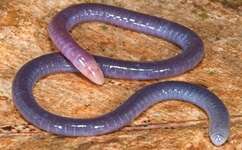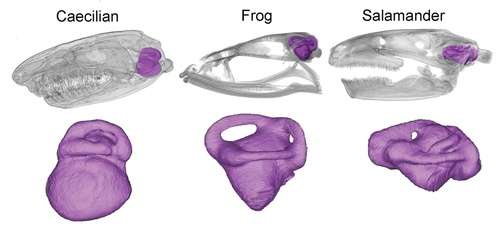Underground amphibians evolved unique ear

Caecilians have developed an oversized organ in their ears to help them sense underground vibrations, say scientists.
The study, published in the Journal of Anatomy, found that caecilians – an worm-like underground amphibian – have one organ in the ear much larger than in other amphibians like frogs and salamanders.
'Animals living in soil experience the same pressures as an animal flying or swimming, so we predicted that their ears should look the same,' says Dr Hillary Maddin of Carleton University Canada, a lead author on the study who conducted the research while at Harvard University, USA. 'But caecilians have a much larger ventral organ, which is probably used for transmitting vibrations from the ground to the ear.'
'Living underground means that their ears are basically non-functioning for hearing airborne sound and being limbless they have their heads on the ground all the time. So by having this larger organ to determine vibrations it helps them see if prey or predators are around. It's unique to this group.' she continues.
The team studied salamanders, frogs and caecilians using a CT scanner, similar to those used in hospitals. This produced a digital image of the animals' ears which the team used to build 3D digital replicas of each.

They then measured any variation between the inner canals and shapes of the ears and quickly spotted the unusual ventral organ in every single caecilian specimen.
'This is the first time this organ has been quantified – people have noted it before but it's never been shown that it's truly distinct in all members of the group. Even primitive species all have a larger vibration sensing organ,' says Maddin.
The larger ventral organ is not seen in other subterranean animals, which means that despite facing the same problems living underground brings as molerats, the caecillians evolved a different way of solving them.
'It was amazing to show that animals respond to the same environmental pressures but evolve different coping mechanisms. Caecilians are doing something different with their ears to other underground animals. So each group might be doing something different,' Maddin explains.
The team are now hoping to understand more about why, despite living in similar conditions the caecilians have evolved to have a much better vibration sensing ability. They suspect that it means the evolution of the ears was based on behavioural differences as opposed to the environment.
'Caecilians seem to just get in a hole and sit there, whereas an animal like a molerat keeps moving. This might explain why all the senses in the caecilians seem to be degenerating, while molerats utilise all of their senses to get information on their surroundings' says Maddin. 'We know in the lab they're quite sedentary, so even though they have the ability to exploit the 3D environment, they may not actually be doing that. We want to know what is making them different, even though they're doing the same as other underground animals.'
Ultimately Maddin and her colleague, Emma Sherratt, now of Iowa State University, USA, hope to be able to use this new information to interpret the ears of various fossils to show in detail how the anatomy of the ear evolved.
More information: Maddin, H. C. and Sherratt, E. (2014), "Influence of fossoriality on inner ear morphology: insights from caecilian amphibians." Journal of Anatomy, 225: 83-93. DOI: 10.1111/joa.12190
Provided by PlanetEarth Online


















